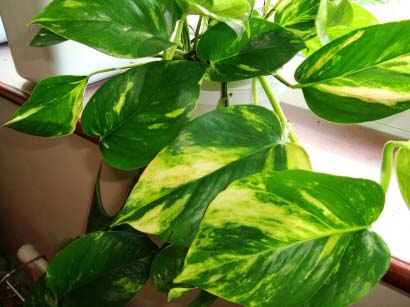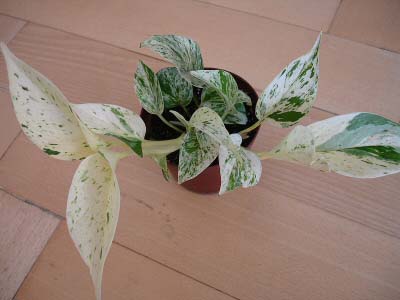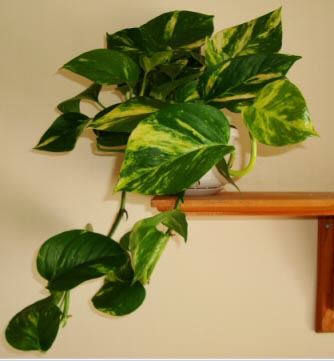





Pothos is an easy to grow house and office plant that has multiple names, both scientific and common, which can make it difficult to identify by name alone. By sight though things are quite different, with its obvious trailing habit and distinctive leaf markings fully on show  it becomes an easily recognisable indoor plant. First though lets sort this naming business out.
it becomes an easily recognisable indoor plant. First though lets sort this naming business out.
It used to be known scientifically as Scindapsus aureau or Phaphidophora aureu. In much of Europe it tends to be known as Scindapsus aureus, in America and Canada, Epipremnum pinnatum. The Botanist will call it Epipremnum aureus. The common names it goes by are just as varied, Australian Native Monstera, Devil's Ivy, Golden Pothos, Ivy Arum, Silver Vine and Taro Vine to name just a few. So in our pages to keep things simple, we are going to use its current scientific name, Epipremnum aureus and most popular common name, Pothos. Phew glad we sorted that.
The good news is that there are only really two cultivars of Epipremnum aureum grown as house plants. The most popular is Aureum (pictured above), this is a mid green and mustard variegated plant which is the most tolerant and adaptable of the two. Being quite hardy and taking poor light and erratic watering for quite some time, it also has another special trait; unlike almost all other variegated plants if you put Pothos in low light conditions it will still hold on to its variegation well. Another plus is that Dr Wolverton ranks it as one of the best house plants to clean the air.
Marble Queen (pictured below) is the second cultivar of Pothos you can easily find. Although it has stunning marbled white and green foliage it's harder to care for and therefore  hasn't become as common as the Aureum. It does grow slowly however, which is an advantage if you want a plant for a space that wont be out grown for a while.
hasn't become as common as the Aureum. It does grow slowly however, which is an advantage if you want a plant for a space that wont be out grown for a while.
Unfortunately although Pothos is a fantastically easy care plant to have in your home, its popularity has waned over recent years and so it can be some what difficult to come by. This comes down to the plant committing two faux pas when it comes to modern interior design. Firstly given time it creeps, trails and clings around anything in its path, spreading and sliding towards sources of light. Once a highly desirable feature (because you could train its long vines above windows and beams to soften hard lines and edges) now this can be looked upon as untidy and messy.
To hell with current fashions, Pothos looks great and probably always will
Secondly it looks beautiful growing up a moss stick. It's a somewhat sad thing to say but many people under the age of 25 reading this will have absolutely no idea what a moss stick actually is. For those who remember them fondly lets just take a moment here to reminisce. To those who don't know, a Moss Stick is normally a vertical hollow tube made of plastic mesh with wide holes, the inside of the tube is typically filled with a moss like material. The entire "stick" is then placed and firmed into the pot and over time the stick becomes covered and hidden by the growing plant. By supporting the plant that's hiding it, the moss stick turns a normally low growing and spreading plant into a compact and vertical column of greenery. Genius.
You can still buy moss sticks if you look hard enough or choose to let Pothos clamber over your entire home, failing that you can pinch out the tips on a regular basis and keep it neat and tidy in a simple container. So to hell with current fashions, Pothos looks great and probably always will.
Light
Average light would be best for your Pothos plant. Growth will be slow if you choose a very dark spot, this will also create sparse "vines" with leaves quite far apart. Very bright spots will eventually destroy the plant.
Watering
Water your Pothos regularly during the growing seasons and a lot less in Winter. It wont mind being under watered, but over watering needs to be avoided otherwise you risk rot setting in. The soil should never be soggy or wet.
Humidity
If given the choice Pothos enjoys high humidity, however it's not vital for a healthy plant and will be equally fine in a location with lower humidity levels.
Feeding
There is no need to feed unless the plant is growing, so a light feed once every few months over Spring and Summer using a general all purpose fertiliser.
Temperature
No lower than 10°C / 50°F in Winter and ideally between 18°C - 24°C / 65°F - 75°F in the other seasons.
Repotting
You only need to repot your Pothos when the roots are are so congested the plant starts to suffer. The most obvious sign of this is when the leaves are drooping despite being well watered or the plant isn't growing any more.
Propagation
Propagating Pothos is really easy. Cut off the tips to create cuttings and either put them in water until they grow roots, or push the cuttings directly into pots of moist compost. They root easily so you should have a good success rate.
Speed of Growth
Pothos is normally a quick growing houseplant providing you treat it well, it's growth will slow or stop completely if poor care is provided.
Height / Spread
This depends how you are growing Pothos. So to address this it's best to explain a little about the eventual length of the vines first. They can reach impressive  lengths out in the wild, up to 20m / 66ft. They can get very long indoors too but this is rare because although the creeping habit is part of the charm, many home owners will prune when they become too long and unruly. This means the plant can be as tall or as short as you want it to be.
lengths out in the wild, up to 20m / 66ft. They can get very long indoors too but this is rare because although the creeping habit is part of the charm, many home owners will prune when they become too long and unruly. This means the plant can be as tall or as short as you want it to be.
Flowers
Getting flowers on indoor plants is very rare and to be fair it's only because of the beautiful leaves that Epipremnum is grown indoors.
Anything else?
Just like Ivy (Hendera helix), you can pinch out the tips of the vines which will create a more compact and bushier plant as in the picture on the right. Each plant will produce several vines which twine together, this can look quite messy so every now and again gently untangle them.
All parts of Epipremnum are poisonous, especially to cats and dogs.
Copyright © www.100flowers.win Botanic Garden All Rights Reserved